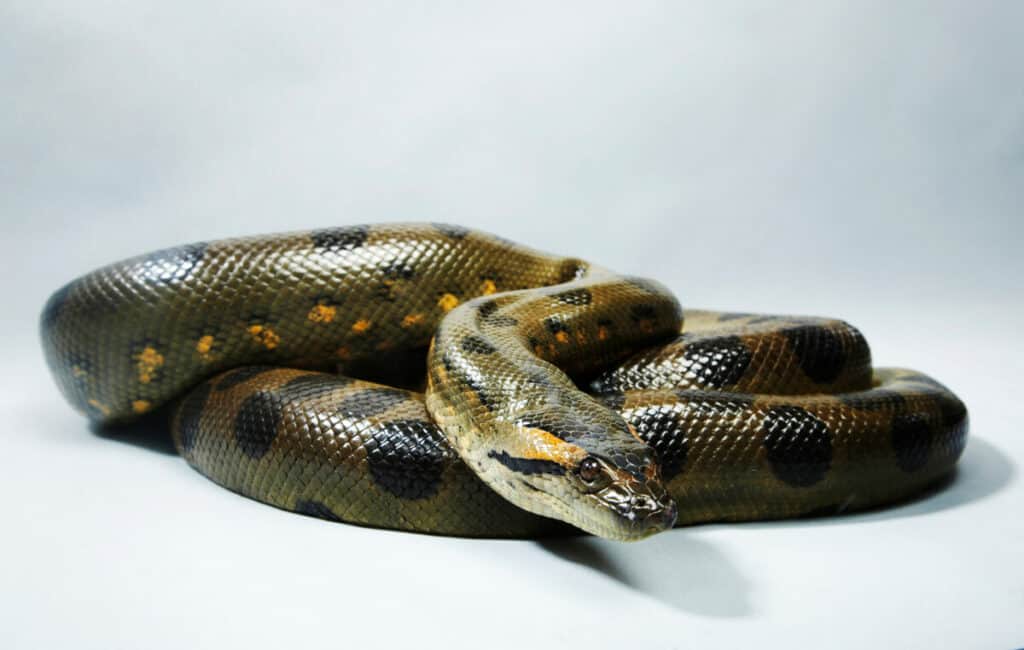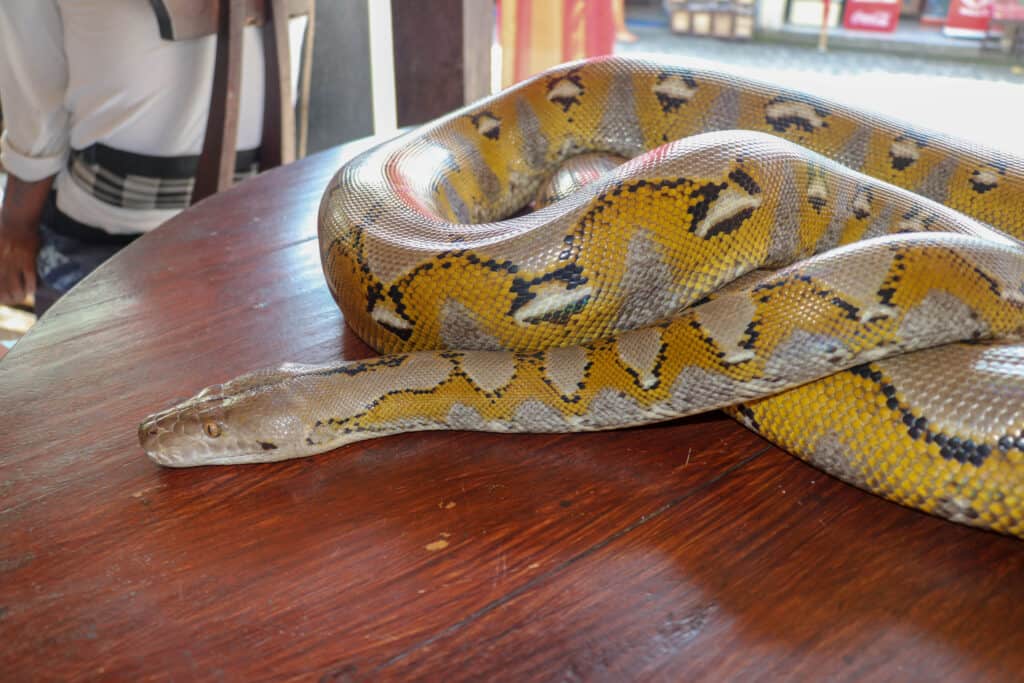
You’ve heard of the biggest snake in the world: it’s the anaconda. Or was it the python? You’ve heard both names with the same claim to big fame attached, but could that mean that they’re the same snake? Are anacondas the same as pythons?
Anacondas and pythons are different in their shape, size, eating habits, and habitat, among other things. Their only similarity is that they’re both nonvenomous constrictors that eat their prey whole. Even here, anacondas may drown their prey while a python always squeezes its prey to death.
Let’s go into some things that make anacondas and pythons different. Once you know how they’re different in build, classification, and living habits, you’ll know for sure that they’re not the same snake.
Anaconda Vs Python Build Appearance

First, anacondas and pythons are built very differently. Both groups contain the largest snakes in the world, with anacondas being the heaviest and pythons growing the longest.
Anacondas grow to be about 550 pounds on average. That’s really big! On the other hand, their length will usually only get to be about 25 feet. So they’re not incredibly long, but they are incredibly thick. Some are a whole foot in diameter. Can you imagine a rope of muscle thicker than your head and longer than a camper van? That’s a pretty big snake!
Pythons, on the other hand, are less about the weight and more about the length. The bigger species of pythons can get up to 33 feet. However, a python that’s 33 feet long still won’t outweigh an anaconda. A 20-foot-long anaconda will weigh more than a python that’s much longer than it.
The longest python is a reticulated python, and its maximum weight comes in around 350 pounds. Comparing that to an anaconda, you’d have to find a pretty young anaconda to find one that weighed less than that.
There are other things that make the two different kinds of snakes look different apart from the length and weight. For one thing, anacondas have their eyes on top of their head. Pythons have more triangular heads with their eyes lower down on the sides instead of right on top.
Different Classification
When there’s a whole separate branch of classification dedicated to two kinds of snakes, you can definitely be sure anacondas are not the same as pythons.
Pythons are classified in the family Pythonidae. About 30 different species of pythons make up this family. The species of python in this family are all proportionally long and lithe constrictors, though they vary both in length and markings. The reticulated python gets to about 33 feet, while the pygmy python will hardly reach 23 inches.
Many pythons have patterns of varying colors of brown, but the green tree python is a distinct pale green color, and the olive python is a solid olive color along its whole length, without any distinct pattern.
On the other hand, anacondas are members of the boa family, called Boidae. Compared to the family of 30 pythons, there are only 4 recognized species of anaconda: the green anaconda, the yellow anaconda, the dark-spotted anaconda, and the Bolivian anaconda. All four are patterned with brown or black spots.
Green anacondas are the most well-known of the bunch because they’re the biggest. A few have even been recorded to grow to 30 feet long. Yellow anacondas are also called Paraguayan anacondas, but the scales surrounding their spot pattern are a very bright yellow. Dark-spotted anacondas have more prominent spots. The Bolivian anaconda’s pattern is more regular which makes it easier to spot.
Python Vs Anaconda Habits
Pythons prefer to eat mammals and birds. Anacondas, however, don’t really care what they eat as long as it satisfies them. Along with any big mammals they can grab, like pigs or jaguars, anacondas will eat turtles, fish, and even other snakes. In fact, a female anaconda might even try to eat her mate if she’s hungry enough.
When it comes to how they get their prey, there is also some difference between the two kinds of snakes. They’re still both constrictors, they both like to hunt at night, and they both try to ambush their prey instead of chasing it, but the way they kill it can be different.
Pythons will always squeeze their prey to death, but an anaconda, which spends a lot of time in the water, may try to drown it instead. Whatever the method, though, both constrictors will unhinge their jaws to swallow the prey whole once it’s dead.
Pythons vary so much in size that it’s hard to pin down exactly how often they need to eat, but anacondas are a lot more straightforward. Since anacondas eat so much at a time, it takes them several months to digest their food, so they tend to only eat 4 or 5 times per year. In fact, different python species range in size from just a few feet long all the way up to 30 plus feet long.
For this reason, pythons are more likely kept as pets. In fact, you can check out my top pythons and boas to keep as pets here! I will go ahead and tell you that the anaconda does not make the list.
Anacondas and Pythons Live In Different Environments
One of the reasons anacondas and pythons can be so different is because they’re from different places in the world. Pythons are native to the East hemisphere: places in Africa, Asia, and Australia. Anacondas live in the Western hemisphere: mainly in the Amazon of South America.
As such, anacondas are all good swimmers. Pythons usually are as well, but they’re a lot more varied in the habitats they like. Different species of python thrive in grasslands, rainforests, and savannas alike, which can all have very different challenges and adaptational needs. Different habitats mean different changes to each species.
Anacondas and Pythons Are Born Differently
One big reason that they have different classifications is because of the difference in how they produce their young. Pythons all lay eggs like other snakes, but anacondas, like other boas, give birth to live young.
That brings us back to why the female anaconda might end up eating her mate: anacondas don’t like eating while they’re pregnant, which takes around seven months. So, the female has to eat a lot before then, like a bear before hibernation. If the male doesn’t get away quickly enough, he’ll be part of that big beforehand gorge.
